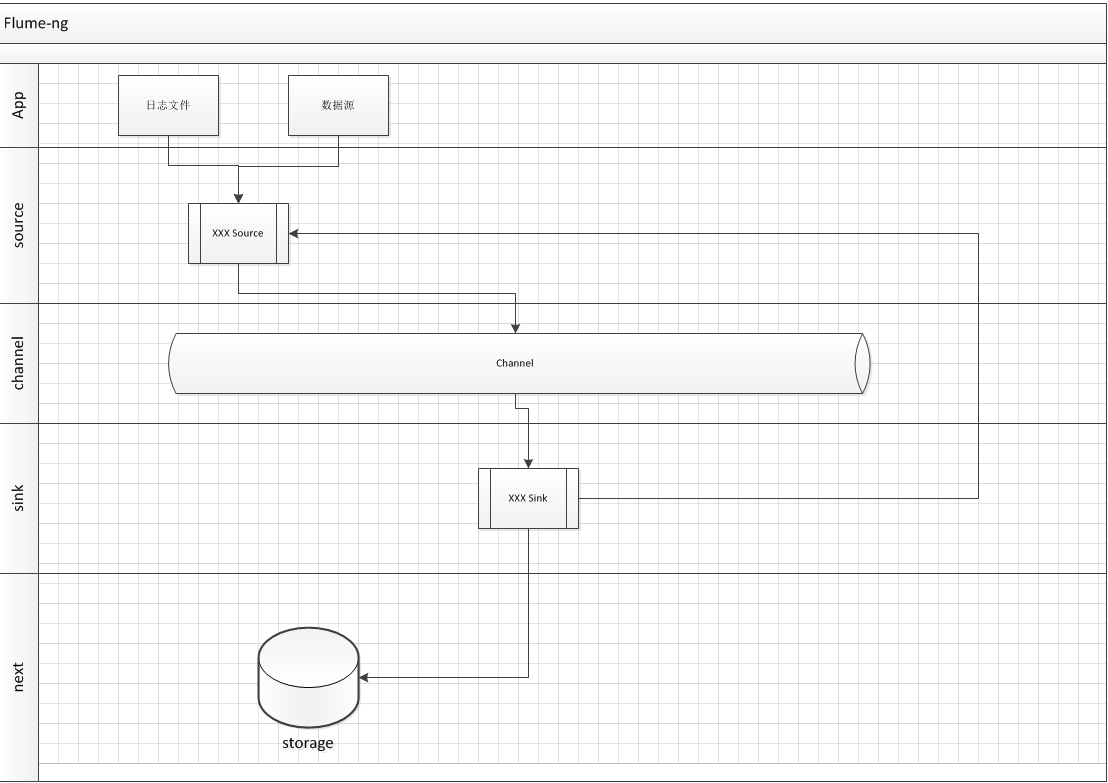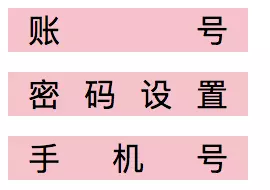转载:http://blog.csdn.net/simonchi/article/details/43308677
概览
flume-ng中最重要的核心三大组件就是source,channel,sink
source负责从源端收集数据,产出event
channel负责暂存event,以备下游取走消费
sink负责消费通道中的event,写到最终的输出端上

以上是总体的一个简单结构图,下面我们来深入每一个组件的内部看看:
1、Source
source接口的定义如下:
[java] view plain copy print ? 

- @InterfaceAudience.Public
- @InterfaceStability.Stable
- public interface Source extends LifecycleAware, NamedComponent {
- /**
- * Specifies which channel processor will handle this source’s events.
- *
- * @param channelProcessor
- */
- public void setChannelProcessor(ChannelProcessor channelProcessor);
- /**
- * Returns the channel processor that will handle this source’s events.
- */
- public ChannelProcessor getChannelProcessor();
- }
source生成event并且调用配置的channelprocessor的相关方法,持续的将events存入配置的channel里
channelProcessor中有通道选择器和拦截器链,该过程处在source端收到数据和放入通道直接
看一个source的具体工作流程:ExecSource
该source继承了两个类
1、NamedComponent
负责给每一个组件取一个唯一标识,就是名字,这个名字来源于我们的配置
2、LifecycleAware
负责组件的启停和状态维护
Source接口的直接实现类是AbstractSource抽象类
该类中就定义了通道处理器
还有一个生命状态周期的枚举类型
[java] view plain copy print ? 

- public enum LifecycleState {
- IDLE, START, STOP, ERROR;
- public static final LifecycleState[] START_OR_ERROR = new LifecycleState[] {
- START, ERROR };
- public static final LifecycleState[] STOP_OR_ERROR = new LifecycleState[] {
- STOP, ERROR };
- }
这里就定义了一个组件会有的4种状态
实现接口的启停组件方法,方法体中只有一个状态的赋值,具体实现,我们来看一个具体的Source——ExecSource
读取配置方面很简单,这里就不说了,看下start方法
[java] view plain copy print ? 

- public void start() {
- logger.info(“Exec source starting with command:{}“, command);
- executor = Executors.newSingleThreadExecutor();
- runner = new ExecRunnable(shell, command, getChannelProcessor(), sourceCounter,
- restart, restartThrottle, logStderr, bufferCount, batchTimeout, charset);
- // FIXME: Use a callback-like executor / future to signal us upon failure.
- runnerFuture = executor.submit(runner);
- /*
- * NB: This comes at the end rather than the beginning of the method because
- * it sets our state to running. We want to make sure the executor is alive
- * and well first.
- */
- sourceCounter.start();
- super.start();
- logger.debug(“Exec source started”);
- }
该方法内部就是启动了一个线程去执行我们配置的终端命令
前面一篇文章也说过从入口分析如何调用到该start方法,以及调用频率:http://blog.csdn.net/simonchi/article/details/42970373
2、channel
对于通道来说,最重要的就是event的维护,flume的核心就是要中转这些event,所以event一定不能出事
Channel接口定义如下:
- @InterfaceAudience.Public
- @InterfaceStability.Stable
- public interface Channel extends LifecycleAware, NamedComponent {
- /
- <p>Puts the given event into the channel.</p>
- <p><strong>Note</strong>: This method must be invoked within an active
- {@link Transaction} boundary. Failure to do so can lead to unpredictable
- results.</p>
- @param event the event to transport.
- @throws ChannelException in case this operation fails.
- @see org.apache.flume.Transaction#begin()
- /
- public void put(Event event) throws ChannelException;
- /
- <p>Returns the next event from the channel if available. If the channel
- does not have any events available, this method must return {@code null}.
- </p>
- <p><strong>Note</strong>: This method must be invoked within an active
- {@link Transaction} boundary. Failure to do so can lead to unpredictable
- results.</p>
- @return the next available event or {@code null} if no events are
- available.
- @throws ChannelException in case this operation fails.
- @see org.apache.flume.Transaction#begin()
- /
- public Event take() throws ChannelException;
- /**
- @return the transaction instance associated with this channel.
- */
- public Transaction getTransaction();
- }
|
通道中的event全部都在事务的管理之中
先来看看这个事务的定义
- <pre code_snippet_id=“593798” snippet_file_name=“blog_20150130_5_6226220” name=“code” class=“java”>public interface Transaction {
- public enum TransactionState {Started, Committed, RolledBack, Closed };
- /
- <p>Starts a transaction boundary for the current channel operation. If a
- transaction is already in progress, this method will join that transaction
- using reference counting.</p>
- <p><strong>Note</strong>: For every invocation of this method there must
- be a corresponding invocation of {@linkplain #close()} method. Failure
- to ensure this can lead to dangling transactions and unpredictable results.
- </p>
- /
- public void begin();
- /
- Indicates that the transaction can be successfully committed. It is
- required that a transaction be in progress when this method is invoked.
- /
- public void commit();
- /**
- Indicates that the transaction can must be aborted. It is
- required that a transaction be in progress when this method is invoked.
- /
- public void rollback();
- /*
- <p>Ends a transaction boundary for the current channel operation. If a
- transaction is already in progress, this method will join that transaction
- using reference counting. The transaction is completed only if there
- are no more references left for this transaction.</p>
- <p><strong>Note</strong>: For every invocation of this method there must
- be a corresponding invocation of {@linkplain #begin()} method. Failure
- to ensure this can lead to dangling transactions and unpredictable results.
- </p>
- /
- public void close();
- }
-
|
和我们想想中的一样,也就是一些标准的事务方法的定义,和一个事务状态的枚举类型的定义
基本事务语义抽象类是对它的实现BasicTransactionSemantics
该类定义了两个属性
state状态和initialThreadId,id是唯一的,用来标识事务
构造方法中会赋值为NEW状态,并获取当前事务的一个ID值
重点来看下如下几个方法的具体实现:
- protected void doBegin() throws InterruptedException {}
- protected abstract void doPut(Event event) throws InterruptedException;
- protected abstract Event doTake() throws InterruptedException;
- protected abstract void doCommit() throws InterruptedException;
- protected abstract void doRollback() throws InterruptedException;
- protected void doClose() {}
|
1、doBegin
没什么好说的,就是检查状态是否NEW,ID是否匹配,没有问题后,将状态修改为OPEN,表示事务打开
2、doPut
takeList和putList维护的是希望取出成功和放入成功的event队列
检查ID是否匹配,状态是否打开,event是否为空,为空当然这个put就没意义了
关键看具体是怎么put的?
在FileChannel中有个内部静态类
static class FileBackedTransaction extends BasicTransactionSemantics
- private final LinkedBlockingDeque<FlumeEventPointer> takeList;
- private final LinkedBlockingDeque<FlumeEventPointer> putList;
|
这分别定义了两个双向队列,用于拿和放
- protected void doPut(Event event) throws InterruptedException {
- channelCounter.incrementEventPutAttemptCount();
- if(putList.remainingCapacity() == 0) {
- throw new ChannelException(“Put queue for FileBackedTransaction ” +
- “of capacity ” + putList.size() + “ full, consider ” +
- “committing more frequently, increasing capacity or ” +
- “increasing thread count. ” + channelNameDescriptor);
- }
- // this does not need to be in the critical section as it does not
- // modify the structure of the log or queue.
- if(!queueRemaining.tryAcquire(keepAlive, TimeUnit.SECONDS)) {
- throw new ChannelFullException(“The channel has reached it’s capacity. ”
- + “This might be the result of a sink on the channel having too ”
- + “low of batch size, a downstream system running slower than ”
- + “normal, or that the channel capacity is just too low. ”
- + channelNameDescriptor);
- }
- boolean success = false;
- log.lockShared();
- try {
- FlumeEventPointer ptr = log.put(transactionID, event);
- Preconditions.checkState(putList.offer(ptr), “putList offer failed ”
- + channelNameDescriptor);
- queue.addWithoutCommit(ptr, transactionID);
- success = true;
- } catch (IOException e) {
- throw new ChannelException(“Put failed due to IO error ”
- + channelNameDescriptor, e);
- } finally {
- log.unlockShared();
- if(!success) {
- // release slot obtained in the case
- // the put fails for any reason
- queueRemaining.release();
- }
- }
- }
|
第一行,跟监控的度量信息有关,表示即将放入通道的event数量+1,监控度量请参考:http://blog.csdn.net/simonchi/article/details/43270461
1、检查队列的剩余空间
2、keepAlive秒时间内获取一个共享信号量,说明put的过程是互斥的
如果该时间内没有成功获取该信号量,那么event放入失败
3、FlumeEventPointer是用来做检查点机制的,因为这是文件通道,会用日志记录的
1、将event和事务id绑定到Pointer上 2、将pointer放入队列尾部 3、通道中的事件队列FlumeEventQueue添加一个未提交的事件,绑定了事务ID
4、释放共享信号量
3、doTake
- protected Event doTake() throws InterruptedException {
- channelCounter.incrementEventTakeAttemptCount();
- if(takeList.remainingCapacity() == 0) {
- throw new ChannelException(“Take list for FileBackedTransaction, capacity ” +
- takeList.size() + “ full, consider committing more frequently, ” +
- “increasing capacity, or increasing thread count. ”
- + channelNameDescriptor);
- }
- log.lockShared();
- /
- 1. Take an event which is in the queue.
- 2. If getting that event does not throw NoopRecordException,
- then return it.
- 3. Else try to retrieve the next event from the queue
- 4. Repeat 2 and 3 until queue is empty or an event is returned.
- */
- try {
- while (true) {
- FlumeEventPointer ptr = queue.removeHead(transactionID);
- if (ptr == null) {
- return null;
- } else {
- try {
- // first add to takeList so that if write to disk
- // fails rollback actually does it’s work
- Preconditions.checkState(takeList.offer(ptr),
- “takeList offer failed ”
- + channelNameDescriptor);
- log.take(transactionID, ptr); // write take to disk
- Event event = log.get(ptr);
- return event;
- } catch (IOException e) {
- throw new ChannelException(“Take failed due to IO error ”
- + channelNameDescriptor, e);
- } catch (NoopRecordException e) {
- LOG.warn(“Corrupt record replaced by File Channel Integrity ” +
- “tool found. Will retrieve next event”, e);
- takeList.remove(ptr);
- } catch (CorruptEventException ex) {
- if (fsyncPerTransaction) {
- throw new ChannelException(ex);
- }
- LOG.warn(“Corrupt record found. Event will be ” +
- “skipped, and next event will be read.”, ex);
- takeList.remove(ptr);
- }
- }
- }
- } finally {
- log.unlockShared();
- }
- }
|
1、剩余容量检查
2、检查点机制,日志记录操作,从头部取event
3、从takeList中删除该event
4、doCommit
- protected void doCommit() throws InterruptedException {
- int puts = putList.size();
- int takes = takeList.size();
- if(puts > 0) {
- Preconditions.checkState(takes == 0, “nonzero puts and takes ”
- + channelNameDescriptor);
- log.lockShared();
- try {
- log.commitPut(transactionID);
- channelCounter.addToEventPutSuccessCount(puts);
- synchronized (queue) {
- while(!putList.isEmpty()) {
- if(!queue.addTail(putList.removeFirst())) {
- StringBuilder msg = new StringBuilder();
- msg.append(“Queue add failed, this shouldn’t be able to ”);
- msg.append(“happen. A portion of the transaction has been ”);
- msg.append(“added to the queue but the remaining portion ”);
- msg.append(“cannot be added. Those messages will be consumed ”);
- msg.append(“despite this transaction failing. Please report.”);
- msg.append(channelNameDescriptor);
- LOG.error(msg.toString());
- Preconditions.checkState(false, msg.toString());
- }
- }
- queue.completeTransaction(transactionID);
- }
- } catch (IOException e) {
- throw new ChannelException(“Commit failed due to IO error ”
- + channelNameDescriptor, e);
- } finally {
- log.unlockShared();
- }
- } else if (takes > 0) {
- log.lockShared();
- try {
- log.commitTake(transactionID);
- queue.completeTransaction(transactionID);
- channelCounter.addToEventTakeSuccessCount(takes);
- } catch (IOException e) {
- throw new ChannelException(“Commit failed due to IO error ”
- + channelNameDescriptor, e);
- } finally {
- log.unlockShared();
- }
- queueRemaining.release(takes);
- }
- putList.clear();
- takeList.clear();
- channelCounter.setChannelSize(queue.getSize());
- }
|
1、如果putList不为空,提交的是放入通道的事件数量
2、如果takeList不为空,提交的是从通道拿走的事件数量
5、doRollback
- protected void doRollback() throws InterruptedException {
- int puts = putList.size();
- int takes = takeList.size();
- log.lockShared();
- try {
- if(takes > 0) {
- Preconditions.checkState(puts == 0, “nonzero puts and takes ”
- + channelNameDescriptor);
- synchronized (queue) {
- while (!takeList.isEmpty()) {
- Preconditions.checkState(queue.addHead(takeList.removeLast()),
- “Queue add failed, this shouldn’t be able to happen ”
- + channelNameDescriptor);
- }
- }
- }
- putList.clear();
- takeList.clear();
- queue.completeTransaction(transactionID);
- channelCounter.setChannelSize(queue.getSize());
- log.rollback(transactionID);
- } catch (IOException e) {
- throw new ChannelException(“Commit failed due to IO error ”
- + channelNameDescriptor, e);
- } finally {
- log.unlockShared();
- // since rollback is being called, puts will never make it on
- // to the queue and we need to be sure to release the resources
- queueRemaining.release(puts);
- }
- }
|
在此之前,putList,takeList都没有clear,所以这里可以对着两个双向队列回滚操作
以上是文件通道的实现,如果是内存通道,就没有log的检查点记录了,简单多了,不需要维护状态了。
3、sink
sink的接口定义如下:
- @InterfaceAudience.Public
- @InterfaceStability.Stable
- public interface Sink extends LifecycleAware, NamedComponent {
- /
- <p>Sets the channel the sink will consume from</p>
- @param channel The channel to be polled
- */
- public void setChannel(Channel channel);
- /
- @return the channel associated with this sink
- /
- public Channel getChannel();
- /*
- <p>Requests the sink to attempt to consume data from attached channel</p>
- <p><strong>Note</strong>: This method should be consuming from the channel
- within the bounds of a Transaction. On successful delivery, the transaction
- should be committed, and on failure it should be rolled back.
- @return READY if 1 or more Events were successfully delivered, BACKOFF if
- no data could be retrieved from the channel feeding this sink
- @throws EventDeliveryException In case of any kind of failure to
- deliver data to the next hop destination.
- /
- public Status process() throws EventDeliveryException;
- public static enum Status {
- READY, BACKOFF
- }
- }
|
sink与一个通道连接,并消费通道中的events,把它们发送到一个配置的目的地
其实和source的原理大部分相同,同样有一个AbstractSink
我们同样看一个具体实现吧,HDFSEventSink
看它的process方法
- public Status process() throws EventDeliveryException {
- Channel channel = getChannel();
- Transaction transaction = channel.getTransaction();
- List<BucketWriter> writers = Lists.newArrayList();
- transaction.begin();
-
- …………………………
-
- transaction.commit();
- if (txnEventCount < 1) {
- return Status.BACKOFF;
- } else {
- sinkCounter.addToEventDrainSuccessCount(txnEventCount);
- return Status.READY;
- }
- } catch (IOException eIO) {
- transaction.rollback();
- LOG.warn(“HDFS IO error”, eIO);
- return Status.BACKOFF;
- } catch (Throwable th) {
- transaction.rollback();
- LOG.error(“process failed”, th);
- if (th instanceof Error) {
- throw (Error) th;
- } else {
- throw new EventDeliveryException(th);
- }
- } finally {
- transaction.close();
- }
- }
|
这里可以看到,flume-ng在sink端是有事务控制的
事务从 从通道中取event开始,到sink到下一个目的地结束
在这个过程中,任意的失败都会导致事务的回滚,这就保证数据了一致性。







































还没有评论,来说两句吧...